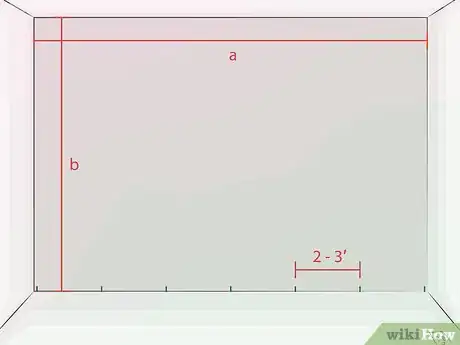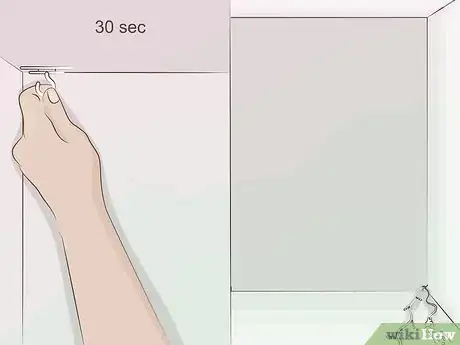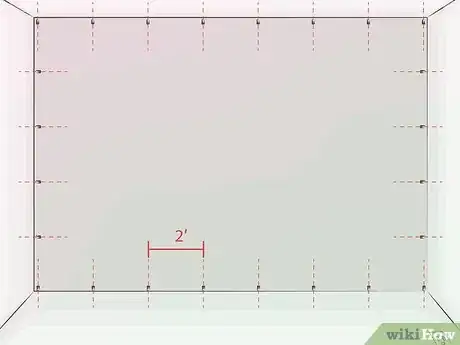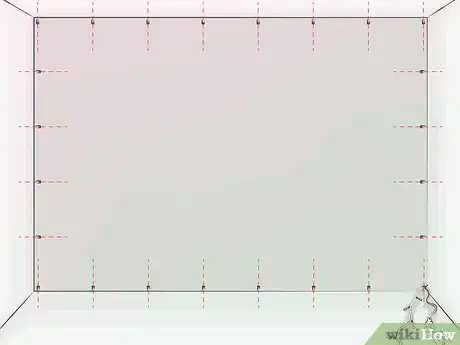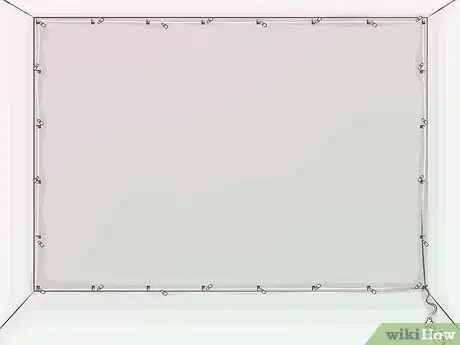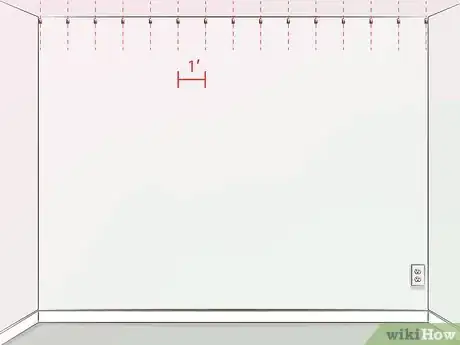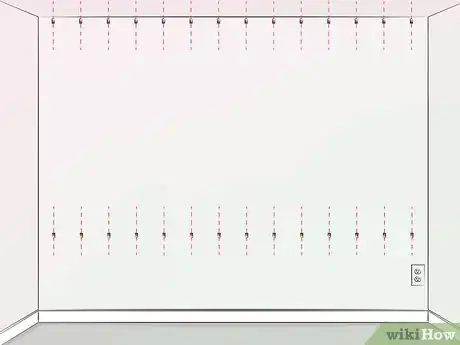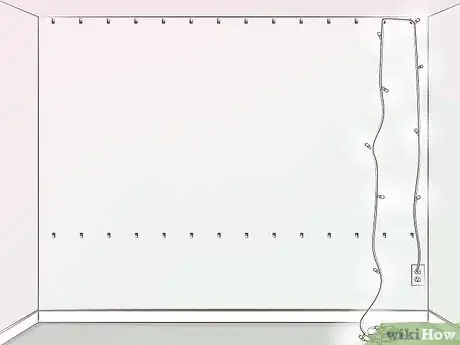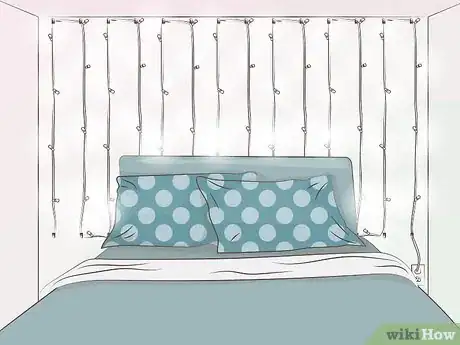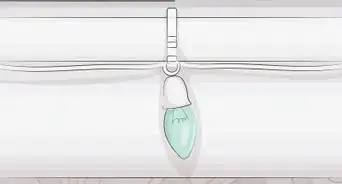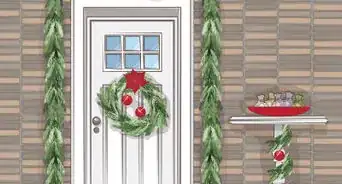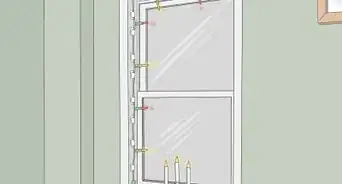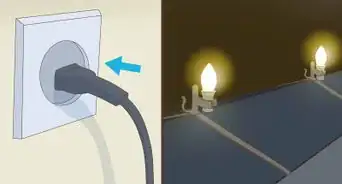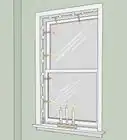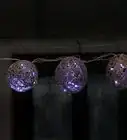This article was co-authored by wikiHow staff writer, Hunter Rising. Hunter Rising is a wikiHow Staff Writer based in Los Angeles. He has more than three years of experience writing for and working with wikiHow. Hunter holds a BFA in Entertainment Design from the University of Wisconsin - Stout and a Minor in English Writing.
There are 11 references cited in this article, which can be found at the bottom of the page.
This article has been viewed 104,234 times.
Learn more...
String lights are useful for decorating around the holidays, but you can also use them to add soft light to any room in your home. Hanging the lights from your ceiling can add a fun design element and help brighten up your space. There are many different patterns you can try when you put up your lights, such as a zig-zag, a simple outline, or a wall design. When you’re finished putting up your lights, your space will feel comfortable and cozy!
Steps
Making a Zig-Zag Pattern
-
1Measure your room and choose how far apart to space your lights. Use a tape measure to find the length and width of the room where you want to hang your lights. Once you know the dimensions, choose the distance you want to have between your anchor points on the ceiling. If you put them closer together, you’ll need to use more lights but your room will be brighter.[1]
- For example, if you want a soft light throughout your entire room, choose to space your lights 2–3 ft (61–91 cm) apart from one another.
- String lights can be purchased from hardware and home design stores.
Tip: Look for string lights before and after the Christmas season when many go on sale.
-
2Hang the first hook from your ceiling near the outlet you’re using. Look for small removable adhesive clips or hooks that you can put onto your ceiling without damaging it. Place your first hook directly above your power outlet so you have an easy place to plug it in. Remove the adhesive backing from your clip and press it onto the ceiling for 30 seconds.[2]
- If you don’t want a portion of your string lights hanging down your wall to the outlet, try running the lights down a corner of your room or using an extension cord.
- If you want a more permanent lighting solution or if you have a popcorn ceiling, get clips that you can easily nail into your ceiling instead.
- If you have a drop ceiling, place the hook on one of the supports instead of on the tiles.
Advertisement -
3Space the hooks along the edge of your ceiling. Install the rest of your hooks across the length of the wall at the distance you chose earlier. Press the adhesive backing onto your ceiling and hold it in place for at least 30 seconds so it’s secure. Work out from your first hook towards the edges of your room so you have even spacing between them.[3]
-
4Offset the hooks on the other wall by half the distance between your hooks. Find the point on the opposite side of your room that lines up with your first hook. Instead of placing your hook directly in line with the one on the other side of the room, move it over by half of the distance you’re using. That way, your lights will make the zig-zag pattern on your ceiling. Install the rest of the hooks along the ceiling, working towards the edges of your room.[4]
- For example, if you spaced your hooks 2 ft (61 cm) on the first wall, offset the hooks on the other side of your room by 1 ft (30 cm).
-
5String the lights tightly between the hooks. Start from the hook closest to your outlet. Run the lights across your ceiling to the other side across the length of your ceiling. When you reach a hook, pull the lights tight and coil the string once around the hook. Continue working in a zig-zag pattern until you’ve covered your entire ceiling.[5]
- If you want a more relaxed look to your lights, let them hang down slightly from the ceiling instead of pulling them tight.
Outlining Your Ceiling with String Lights
-
1Place hooks around the edge of your ceiling every 2 ft (61 cm). Use adhesive-backed cable hooks so you don’t damage your ceiling while hanging your lights. Remove the backing from the hook and press it onto the ceiling for 30 seconds until it’s secure. Keep adding hooks around your room at 2 ft (24 in) intervals.[6]
- If you have a popcorn ceiling, you can also use clips that nail into your ceiling instead.
-
2Start hanging your lights above an outlet or at a corner. Plug your lights into the outlet so you know how much of the string needs to hang down your wall. If you want to keep your lights more discrete, run the lights down a corner of your room and to the outlet. Once they’re plugged in, coil the string lights once around the first hook to hold them in place.[7]
- Some of your string lights will hang down your wall into the outlet. Choose an outlet behind a dresser or piece of furniture if you want to hide them.
-
3Run the lights between the hooks. Work around the perimeter of your room, hanging the string lights between each of the hooks. As you reach each of the hooks, coil the string around the hook once so your lights don’t fall down.[8]
- If you want a more relaxed look to your room, let your string lights dangle from the hooks loosely rather than pulling them tight.
Tip: Wrap any extra length of lights you have around the hooks so you don’t have any left hanging on your wall.
Creating a String Light Headboard
-
1Put hooks along the edge of your ceiling every 1 ft (30 cm) behind your bed. Remove the strip from adhesive-backed cable hooks and press it onto your ceiling for at least 30 seconds. This way, you won’t damage your ceiling while hanging your lights. Space the clips 1 foot (30 cm) apart from one another.[9]
- If you have a popcorn ceiling or want a permanent solution, use clips that nail into the rafters.
-
2Place clips 5–6 ft (1.5–1.8 m) below the hooks on your ceiling. Measure 5–6 ft (1.5–1.8 m) down from the clips on your ceiling and attach adhesive hooks to the wall. This way, the lights are pulled tight instead of hanging loosely against the wall.[10]
- Use pushpins in your wall if you don’t mind making small holes in your paint.
-
3Plug in the string lights and drape them over the first 2 top hooks. Plug your lights into the nearest outlet and run them up your wall to one of the top clips on either side. Hold the string lights tight so they make a straight line up your wall. Loop the light string around the hook once to keep it securely in place. Run the lights horizontally to another top hook and wrap it in place.[11]
- If there isn’t an outlet close to the edge, use an extension cord to get them closer.
-
4Wrap the lights around the bottom of 2 of the lower clips. Run your string lights down from the second top hook to the clip on your wall directly underneath it. Pull the lights tight before wrapping them around the clip once before running it to the next clip over. Loop the lights around the clip.[12]
-
5Work in an up and down pattern across your wall. String the lights from the lower clips back up to the ceiling hook. Try to end the lights so they’re hanging down so you don’t have to pin any lights to your ceiling.[13]
Community Q&A
-
QuestionHow do you hang fairy lights from the ceiling?
 wikiHow Staff EditorThis answer was written by one of our trained team of researchers who validated it for accuracy and comprehensiveness.
wikiHow Staff EditorThis answer was written by one of our trained team of researchers who validated it for accuracy and comprehensiveness.
Staff Answer wikiHow Staff EditorStaff AnswerUse damage-free hanging hooks to create your desired pattern on the ceiling. Wrap the light strings around the hooks or thread them through. You can also let the strings of lights droop down slightly to create festoons.
wikiHow Staff EditorStaff AnswerUse damage-free hanging hooks to create your desired pattern on the ceiling. Wrap the light strings around the hooks or thread them through. You can also let the strings of lights droop down slightly to create festoons. -
QuestionHow do you hang lights on the ceiling without nails?
 wikiHow Staff EditorThis answer was written by one of our trained team of researchers who validated it for accuracy and comprehensiveness.
wikiHow Staff EditorThis answer was written by one of our trained team of researchers who validated it for accuracy and comprehensiveness.
Staff Answer wikiHow Staff EditorStaff AnswerYou can purchase damage-free adhesive hooks or clips that stick to your ceiling without any need for drilling or hammering. If you don’t mind small holes, use pushpins or thumb tacks.
wikiHow Staff EditorStaff AnswerYou can purchase damage-free adhesive hooks or clips that stick to your ceiling without any need for drilling or hammering. If you don’t mind small holes, use pushpins or thumb tacks. -
QuestionHow do you hang icicle lights from the ceiling?
 wikiHow Staff EditorThis answer was written by one of our trained team of researchers who validated it for accuracy and comprehensiveness.
wikiHow Staff EditorThis answer was written by one of our trained team of researchers who validated it for accuracy and comprehensiveness.
Staff Answer wikiHow Staff EditorStaff AnswerYou can hang icicle lights in much the same way as any other string light. Attach some damage-free light clips or hooks to the ceiling wherever you want to hang the lights. Icicle lights are designed to hang down in strings, so attach the top of each dangling string to a hook or clip.
wikiHow Staff EditorStaff AnswerYou can hang icicle lights in much the same way as any other string light. Attach some damage-free light clips or hooks to the ceiling wherever you want to hang the lights. Icicle lights are designed to hang down in strings, so attach the top of each dangling string to a hook or clip.
Things You’ll Need
Making a Zig-Zag Pattern
- Tape measure
- Light hooks or clips
- Hammer
- String lights
Outlining Your Ceiling with String Lights
- Light hooks or clips
- String lights
Creating a String Light Headboard
- Light hooks or clips
- String lights
References
- ↑ https://youtu.be/SbPof6s3bIg?t=21
- ↑ https://youtu.be/aVGwX73Y2gw?t=4
- ↑ https://youtu.be/SbPof6s3bIg?t=77
- ↑ https://youtu.be/SbPof6s3bIg?t=98
- ↑ https://youtu.be/SbPof6s3bIg?t=137
- ↑ https://www.collegefashion.net/dorm/how-to-light-your-dorm-room-with-christmas-lights-and-paper-lanterns/
- ↑ https://www.collegefashion.net/dorm/how-to-light-your-dorm-room-with-christmas-lights-and-paper-lanterns/
- ↑ https://youtu.be/tvd7wfEXEp4?t=429
- ↑ https://youtu.be/slQifMY4KUA?t=90
About This Article
To hang string lights from your ceiling, decide what sort of pattern you want for your lights. For example, you could hang them in a zig-zag pattern or create a simple border around the edges of the ceiling. Take some self-adhesive hooks and attach them to your ceiling in the desired pattern. For instance, if you’re making a border, space the hooks out about 2 feet (61 cm) apart all around the edges of your ceiling. Hang the plug end of the string of lights on a hook right above an outlet. Make sure the plug can reach the outlet. Coil the string of lights around the first hook to secure it, then hang it over each of the other hooks until you’ve hung up the entire string. Coil the other end of the string around the final hook to keep it from falling down.
